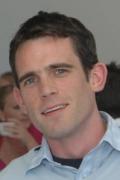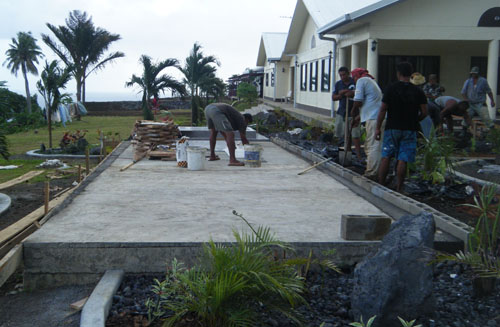
TSUNAMI SPECIAL REPORT 3: Where 14 people died in one family alone, the village of Lalomanu felt the fullest force of last year’s tsunami. As they pause to remember their family members and friends, lots of lessons can be learned from their positive outlook.
APIA: On the stretch of road following the coast between Saleapaga and Lalomanu, there’s a stark reminder of last year’s tsunami.
Scores of homes and fales that were crushed and reduced to ruins have been abandoned and remain exactly as they were left by the waves.
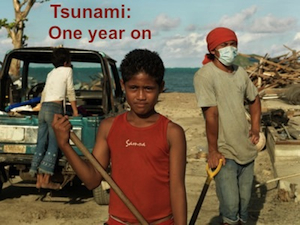 It’s a veritable ghost town.
It’s a veritable ghost town.
Cleaning up in the wake of the tsunami. (Photo: Jane Ussher/Oxfam.)
Families are too afraid to return and many have built new dwellings on higher ground. The steep rise only a hundred metres from the beach means some have traveled away from their traditional neighbourhoods to where the road winds up the mountain at Lalomanu.
Tai Taufua-Apelu says many are too afraid even of going near the water.
”They now stay up here and don’t go down often,” she says.
”There are too many bad memories.”
Taufua-Apelu should know. She has some of her own.
Mountainside units
The owner of Taufua Beach Fales sits on her porch, surrounded by family and villagers who are helping her build new units very high up the mountain.
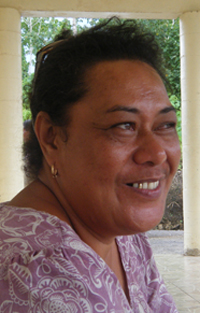 Softly spoken and worn out by all the work, she is hesitant to recall the events of that day.
Softly spoken and worn out by all the work, she is hesitant to recall the events of that day.
14 members of her family were taken away from her in an instant of terror. It’s a simple reality – a whole generation of her children and grandchildren has been decimated.
Guests at the fales also died in the tsunami, not able to escape in time, with the steep cliff wall behind them and the road up the mountain just too far out of reach on foot.
Taufua-Apelu ran to the fales to save the guests, responding to their calls of, ”What do we do?” with a simple order: ”Run.”
Her efforts saved many but she spent six weeks in hospital as a result and the inevitable loss of her children, her sisters, nephews and nieces was soon confirmed.
Despite the tragedy, Taufua-Apelu and her family have been working hard.
Like some other beach fale operations, Taufua Fales has sprung up on the beach where it was before, like a new sapling after a bushfire.
”The government has played its part,” says Taufua-Apelu, ”But I think more should have been done for tourism, and more can be done even now.”
Open for business
Taufua benefited from the Tourism Tsunami Beach Fale Re-building Programme (TTRP), which was financed by the New Zealand government with the help of the United Nations Development Programme.
They opened for business at the end of January – a remarkable turnaround.
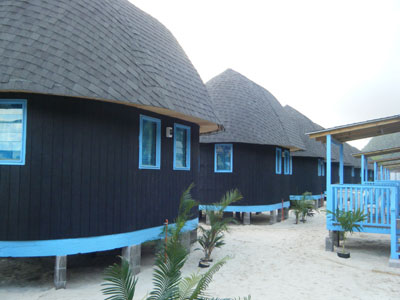 Next door, Litia Sini Beach Resort is preparing to reopen. The loud banging and drilling are signs that despite the restaurant and reception areas not quite finished, guests are arriving and the opening is going ahead.
Next door, Litia Sini Beach Resort is preparing to reopen. The loud banging and drilling are signs that despite the restaurant and reception areas not quite finished, guests are arriving and the opening is going ahead.
Stylish blue and black fales sit up on a new rock wall metres above the white-sand beach.
A couple of girls collect rocks and shells from the sand, putting their final touches on their little strip of paradise.
Lydia Sini is the owner, and the business name takes after her mother, Litia. The resort aims at the mature market – the 40 and over range.
They were fortunate not to have lost any guests in the tsunami, despite being right next door to Taufua.
”We were very lucky, we got everyone out,” says TJ, Lydia’s nephew, who works in the bar.
However, they too lost loved ones, with aunties, uncles and cousins passing away in Lalomanu village.
Guests return
Sini is grateful for the support that the guests have shown her since the tsunami and some are even returning to be with them for the anniversary.
She thinks that the aid distribution could have been better and they have taken longer than others to get back on their feet.
”You can’t have everything, and we are very glad to receive what we did,” she says.
”Apparently there are 56 beach fale businesses in the country. I didn’t know there were so many. But some like us were hit the worst here in Lalomanu.
”I think we deserved more.”
The memorial of the tsunami is going to be a special occasion. For many, it will not be a day of mourning, but a special day to remember loved ones and to be thankful for life.
”It is going to be a family day,” says Sini.
”There will be a memorial walk through the village at 6am, with candlelight and everyone in black and white, of course.
“We will finish in the church for a service and then families can have their own events in the afternoon.”
Sini is thankful that all the building has kept them busy.
“Sometimes you are so busy that you can almost forget, and you would like to forget,” she says.
“But this week is a chance to stop and remember, and to be thankful that we have our lives.”
Mass grave
The optimism and the gratitude of the Samoans in the face of such a catastrophe are inspiring. The depth of trust in the plans of their maker is bewildering, when so many would be understandably angry and resentful.
Tai Taufua-Apelu even says she is thankful for the challenge that she is still coming to terms with. There is now a continual reminder in her front garden – a mass grave is getting its final touches, with marble tiles being laid.
All 14 family members are buried there, next to the grave of Taufua-Apelu’s father.
“A lot of good efforts are coming out of this,” she says.
“Our lives will be better, and good will come from it.”
Taufua-Apelu’s daughter Mana walks through the new units out the back of the property that are still being completed. They cater for guests who want to be away from the beach but still enjoy the view of it from above.
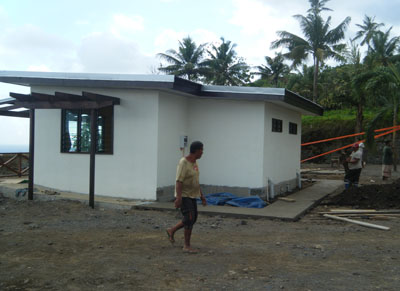 Mana points to the boys and men who are working on the site. “They are all from the village,” she says.
Mana points to the boys and men who are working on the site. “They are all from the village,” she says.
“After the tsunami, many of the young men would get drunk and lay about, without any focus or desire to do anything.
“Projects like this have been good, as their energies are channeled and they have something to achieve, which can draw them out of that depression.”
An earthmover clears the ground for another unit on the cliff top. Unlike many other buildings at resorts, all the materials have been locally manufactured from local products.
“Even the furniture is from Samoa,” says Mana. “Normally those items are shipped in from elsewhere.”
All in the family
It’s just another way that the Taufua family have of helping out their fellow Samoans.
Mana has enormous admiration for her mother, who has held the family together.
“She is amazing. She has helped everyone to focus on what is important.”
“You have to have faith,” she says with conviction. “We all will die at some stage, won’t we?”
The mass grave is a pretty tangible reminder of that. But the fact that these people can still be positive and reach out to others while still greiving is itself something that needs to be seen to be believed.
“This is how we are brought up,” says Taufua-Apelu.
“We are shown how to love and care for others, no matter who they are. No matter what religion you have, we are all one family.”
That seems to sum up her attitude best. Through the loss of her own family, it seems everyone else has become family for Taufua-Apelu.
Pictured (from the tsunami logo): Cleaning up in the wake of the tsunami. Photo: Jane Ussher/Oxfam; survivor Tai Taufua-Apelu ... worn out by all the rebuilding work. Photo: Alex Perrottet/PMC; bright new beach fales at Litia Sini Beach Resort. Photo: Alex Perrottet/PMC; and new units at the Taufua Beach Fales ... ebuilding a welcome focus for the young men. Photo: Alex Perrottet/PMC



